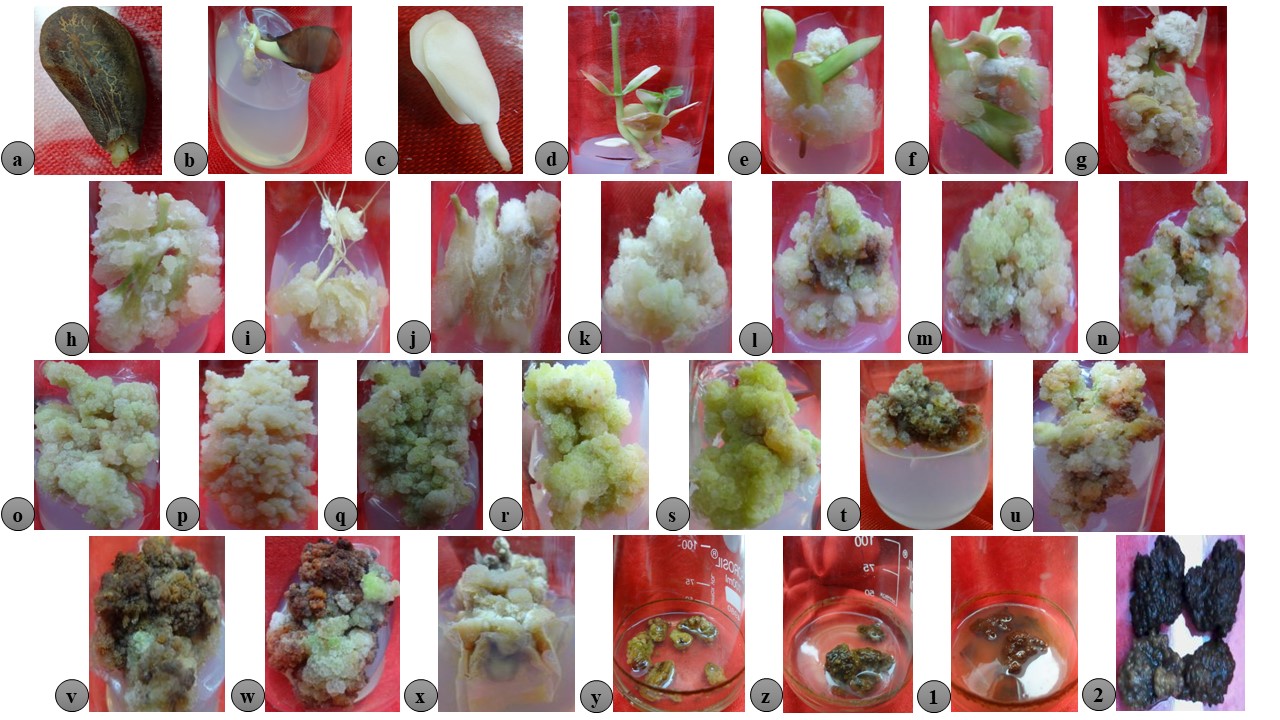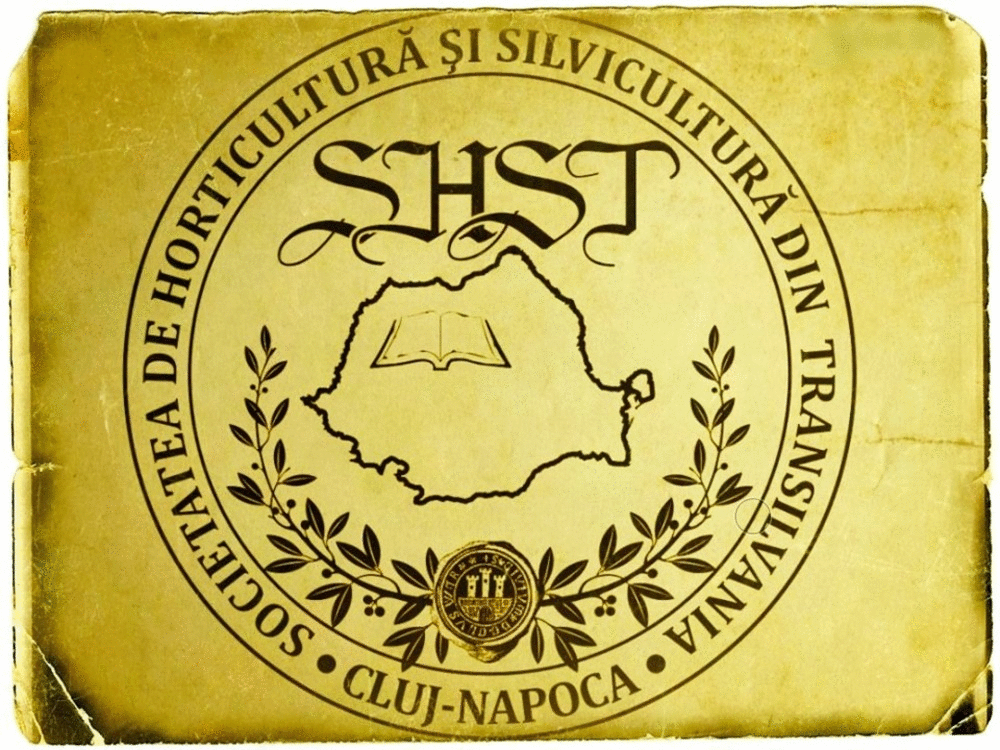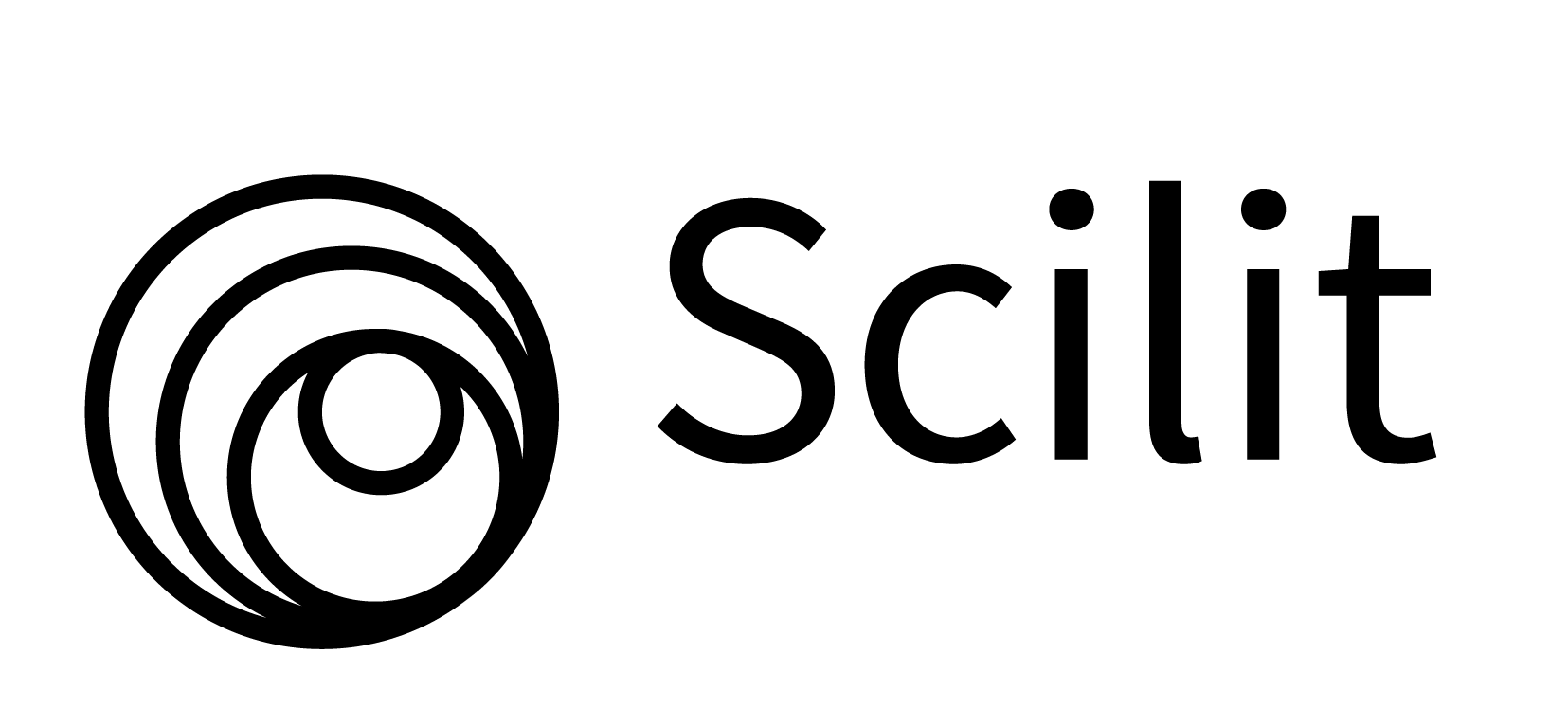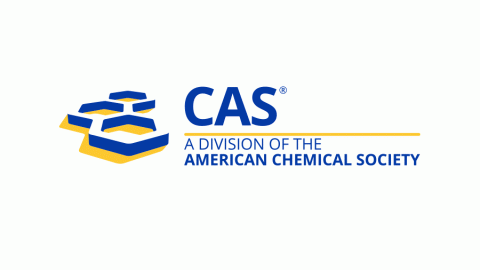Influence of plant growth regulators on morphogenic response, biomass and camptothecin production in the callus cultures of Chonemorpha fragrans (moon) Alston
DOI:
https://doi.org/10.15835/nsb13411052Keywords:
alkaloid, camptothecin, medicinal plants, morphogenic callus, phytochemicals, plant growth regulatorsAbstract
In vitro morphogenic response of mature seed embryo-derived callus cultures of Chonemorpha fragrans was studied using solid and liquid Murashige and Skoog medium amended with cytokinins or their combinations with naphthalene acetic acid at 0.5 mg L-1. The plant growth regulators (PGRs) combination and concentrations tested could not stimulate organogenesis after three subcultivations of the callus cultures on the same PGRs-amended solid medium and when cultivated in the liquid but, formation of morphogenic callus was observed. Evaluation of biomass and camptothecin production showed that the PGRs influenced biomass and CPT yield of the callus cultures. The alkaloid yield of various explants of 3-4 weeks old axenic seedlings was higher in roots (0.019% CPT) followed by mature seed embryos (0.0053%), cotyledons (0.0039%), hypocotyls (0.0024%) and leaves (0.0017%), and no significant difference was observed in yield of CPT from callus induced from the various explants. Camptothecin yield of morphogenic callus cultures cultivated in liquid medium was lower than that of solid due to extracellular leaching effect of the alkaloid. Amount of synthesized CPT in the callus cultures also varied with PGR type and concentration amended in the cultivation medium, and was association with biomass production. Results of the present study suggest that callus cultures offer alternative tissue source for in vitro CPT yield enhancement through biotechnological approaches, with application in the large-scale production of the alkaloid to conserve the ever-decimated natural population of the medicinal woody climber for CPT.
Metrics
References
Banerji J, Chatterji A (1973). A new steroidal alkaloid from Chonemorpha fragrans (Moon) Alston. Iranian Journal of Chemistry 56:1056-57.
Bienaime C, Melin A, Bensaddek L, Attoumbre J, Nava-Saucedo E, Baltora-Rosset S (2015). Effects of plant growth regulators on cell growth and alkaloids production by cell cultures of Lycopodiella inundata. Plant Cell, Tissue and Organ Culture 123(3):523-533. https://doi.org/10.1007/s11240-015-0856-6
Canli FA (2003). Effects of dark and TDZ on callus formation of rose leaf explants. Pakistan Journal of Biological Sciences 6(19):1672-1674. https://doi.org/10.3923/pjbs.2003.1672.1674
Carman JG (1990). Embryogenic cells in plant tissue cultures: occurrence and behavior. In Vitro Cellular and Developmental Biology – Plant 26(8):746-753. https://doi.org/10.1007/BF02623615
Chhabra G, Chaudhary D, Varma M, Sainger M, Jaiswal PK (2008). TDZ-induced direct shoot organogenesis and somatic embryogenesis on cotyledonary node explants of lentil (Lens culinaris Medik.). Physiology and Molecular Biology of Plants 14(4):347-353. https://doi.org/10.1007/s12298-008-0033-z
Clarance P, Khusro A, Lalitha J, Sales J, Paul A (2019). Optimization of camptothecin production and biomass yield from endophytic fungus Fusarium solani strain ATLOY-8. Journal of Applied Pharmaceutical Science 9(10):035-046. https://doi.org/10.7324/JAPS.2019.91005
Czernicka M, Chlosta I, Keska K, Kozieradzka-Kiszkurno M, Abdullah M, Popielarska-Konieczna M (2021). Protuberances are organized distinct regions of long-term callus: histological and transcriptomic analysis in kiwifruit. Plant Cell Reports 40:637-665. https://doi.org/10.1007/s00299-021-02661-0
Espinosa-Leal CA, Puente-Garza CA, García-Lara S (2018). In vitro plant tissue culture: means for production of biological active compounds. Planta 248:1-18. https://doi.org/10.1007/s00425-018-2910-1
Facchini PJ, Bird DA (1998). Developmental regulation of benzylisoquinoline alkaloid biosynthesis in opium poppy plants and tissue cultures. In Vitro Cellular and Developmental Biology – Plant 34(1):69-79. https://doi.org/10.1007/BF02823126
Fehér A (2019). Callus, dedifferentiation, totipotency, somatic embryogenesis: what these terms mean in the era of molecular plant biology?. Frontiers in Plant Science 10:536. https://doi.org/10.3389/fpls.2019.00536
Fulzele DP, Satdive RK (2003). Somatic embryogenesis, plant regeneration, and evaluation of camptothecin content in Nothapodytes foetida. In Vitro Cellular and Developmental Biology – Plant 39(2):212-216. https://doi.org/10.1079/IVP2002368
Guo B, Abbasi BH, Zeb A, Xu LL, Wei YH (2011). Thidiazuron: a multidimensional plant growth regulator. African Journal of Biotechnology 10(45):8984-9000. https://doi.org/10.5897/AJB11.636
Gurel F, Karakas O, Albayrak G, Ari S (2009). Regeneration capacity of mature embryo-derived callus in barley (Hordeum vulgare L.). Acta Biologica Hungarica 60(3):309-319. https://doi.org/10.1556/ABiol.60.2009.3.8
Hagimori M, Matsumoto T, Kisaki T (1980). Studies on the production of Digitalis cardenolides by plant tissue culture I. Determination of digitoxin and digoxin contents in first and second passage calli and organ redifferentiating calli of several Digitalis species by radioimmunoassay. Plant and Cell Physiology 21(8):1391-1404. https://doi.org/10.1093/pcp/21.8.1391
Hsia CN, Korban SS (1996). Organogenesis and somatic embryogenesis in callus cultures of Rosa hybrida and Rosa chinensis minima. Plant Cell, Tissue and Organ Culture 44(1):1-6. https://doi.org/10.1007/BF00045906
Huetteman CA, Preece JE (1993). Thidiazuron: a potent cytokinin for woody plant tissue culture. Plant Cell, Tissue and Organ Culture 33(2):105-119. https://doi.org/10.1007/BF01983223
Ikeuchi M, Sugimoto K, Iwase A (2013). Plant callus: mechanisms of induction and repression. The Plant Cell 25(9):3159-3173. https://doi.org/10.1105/tpc.113.116053
Ikuta A, Syono K, Furuya T (1974). Alkaloids of callus tissues and redifferentiated plantlets in the Papaveraceae. Phytochemistry 13(10):2175-2179. https://doi.org/10.1016/0031-9422(74)85023-5
Isah T (2015a). Adjustments to in vitro culture conditions and associated anomalies in plants. Acta Biologica Cracoviensia Series Botanica 57(2):9-28. https://doi.org/10.1515/abcsb-2015-0026
Isah T (2015b). Rethinking Ginkgo biloba L.: medicinal uses and conservation. Pharmacognosy Reviews 9(18):140. https://doi.org/10.4103/0973-7847.162137
Isah T (2016). Induction of somatic embryogenesis in woody plants. Acta Physiologiae Plantarum 38:118. https://doi.org/10.1007/s11738-016-2134-6
Isah T (2017). Production of camptothecin in the elicited callus cultures of Nothapodytes nimmoniana (J. Graham) Mabberly. Chemical Papers 71(6):1091-1106. https://doi.org/10.1007/s11696-016-0056-9
Isah T, Mujib A (2013). In vitro plant regeneration of coffee senna (Senna occidentalis) from hypocotyl-derived callus. Acta Biologica Cracoviensia Series Botanica 55(2):120-25. https://doi.org/10.2478/abcsb-2013
Isah T, Mujib A (2015). Enhanced in vitro seedling recovery in Nothapodytes nimmoniana. British Biotechnology Journal 6(1):2231-2927. https://doi.org/10.9734/BBJ/2015/15368
Isah T, Mujib A (2015b). In vitro propagation and camptothecin production in Nothapodytes nimmoniana. Plant Cell, Tissue and Organ Culture 121(1):1-10. https://doi.org/10.1007/s11240-014-0683-1
Isah T, Mujib A (2015c). Camptothecin from Nothapodytes nimmoniana: review on biotechnology applications. Acta Physiologiae Plantarum 37:106. https://doi.org/10.1007/s11738-015-1854-3
Isah T, Umar S (2018). Influencing in vitro clonal propagation of Chonemorpha fragrans (moon) Alston by culture media strength, plant growth regulators, carbon source and photoperiodic incubation. Journal of Forestry Research 31:27-43. https://doi.org/10.1007/s11676-018-0794-3
Isah T, Umar S (2019). Proteome study of embryogenic competence acquisition in the callus cultures of Nothapodytes nimmoniana (J. Graham) Mabberly. Acta Physiologiae Plantarum 41:96. https://doi.org/10.1007/s11738-019-2896-8
Isah T, Umar S, Mujib A, Sharma MP, Rajasekharan PE, Zafar N, Frukh A (2018). Secondary metabolism of pharmaceuticals in the plant in vitro cultures: strategies, approaches, and limitations to achieving higher yield. Plant Cell, Tissue and Organ Culture 132(2):239-265. https://doi.org/10.1007/s11240-017-1332-2
Isah T (2019). Proteome study of somatic embryogenesis in Nothapodytes nimmoniana (J. Graham) Mabberly. 3 Biotech 9(4):119. https://doi.org/10.1007/s13205-019-1637-4
Jaleel CA, Gopi R, Gomathinayagam M, Panneerselvam R (2009). Traditional and non-traditional plant growth regulators alter phytochemical constituents in Catharanthus roseus. Process Biochemistry 44(2):205-209. https://doi.org/10.1016/j.procbio.2008.10.012
Kai G, Wu C, Gen L, Zhang L, Cui L, Ni X (2015). Biosynthesis and biotechnological production of anti-cancer drug Camptothecin. Phytochemistry Reviews 14(3):525-539. https://doi.org/10.1007/s11101-015-9405-5
Karwasara VS, Dixit VK (2013). Culture medium optimization for camptothecin production in the cell suspension cultures of Nothapodytes nimmoniana (J. Graham) Mabberley. Plant Biotechnology Reports 7(3):357-369. https://doi.org/10.1007/s11816-012-0270-z
Kedari P, Malpathak NP (2014). Hairy cultures of Chonemorpha fragrans (Moon) Alston.: a potential plant for camptothecin production. Indian Journal of Biotechnology 13(2):231-235.
Kedari P, Malpathak NP (2016). Screening of Chonemorpha fragrans bioactive extracts for cytotoxicity potential and inhibition studies of key enzymes involved in replication. Pharmacognosy Magazine 12(46):297. https://doi.org/10.4103/0973-1296.185708
Kehie M, Kumaria S, Tandon P (2012). In vitro plantlet regeneration from nodal segments and shoot-tips of Capsicum chinense Jacq. cv. Naga King Chili. 3 Biotech 2(1):31-35. https://doi.org/10.1007/s13205-011-0025-5
Khan S, Karnat NM, Shankar D (2005). India's foundation for the revitalization of local health traditions. Pioneering In Situ conservation strategies for medicinal plants and local cultures. Herbalgram 68:34-48.
Kulkarni AV, Malpathak NP (2006). Micropropagation of Chonemorpha fragrans (moon) Alston: an endangered medicinal plant. Indian Drugs Bombay 43(12):1001.
Kulkarni AV, Patwardhan AA, Lele U, Malpathak NP (2010). Production of camptothecin in cultures of Chonemorpha grandiflora. Pharmacognosy Research 2(5):296-299. https://doi.org/10.4103/0974-8490.72327
Li Z, Liu Z (2003). Effects of benzyladenine and naphthalene acetic acid on growth and camptothecin accumulation in Camptotheca acuminata seedlings. Journal Plant Growth Regulation 22(3):205-216. https://doi.org/10.1007/s00344-003-0015-x
Liu Z, Adams J (1996). Camptothecin yield and distribution within Camptotheca acuminata trees cultivated in Louisiana. Canadian Journal of Botany 74(3):360-365. https://doi.org/10.1139/b96-045
Malik S, Zia M, Chaudhary MF (2007). In vitro plant regeneration from direct and indirect organogenesis of Momordica charantia. Pakistan Journal of Biological Sciences 10(22):4118-4122. https://doi.org/10.3923/pjbs.2007.4118.4122
Malik SK, Chaudhury R, Rajwant KK (2005). Rapid in vitro multiplication and conservation of Garcinia indica: a tropical medicinal tree species. Scientia Horticulturae 106(4):539-553. https://doi.org/10.1016/j.scienta.2005.05.002
Miao Y, Zhu Z, Guo Q, Yang X-H, Liu L, Sun Y, Wang C (2016). Dynamic changes in carbohydrate metabolism and endogenous hormones during Tulipa edulis stolon development into a new bulb. Journal of Plant Biology 59(2):121-132. https://doi.org/10.1007/s12374-016-0456-y
Mingzhang A, Jing W, Yue S, Wentao G, Longjiang Y (2011). Camptothecin distribution and content in Nothapodytes nimmoniana. Natural Product Communications 6(2):197-200. https://doi.org/10.1177/1934578X1100600210
Mujib A, Tonk D, Gulzar B, Maqsood M, Ali M (2020). Quantification of taxol by high-performance thin layer chromatography in Taxus wallichiana callus cultivated in vitro. Journal of Biotechnology, Computational Biology and Bionanotechnology 102(4):337-347. https://doi.org/10.5114/bta.2020.100425
Mulder-Krieger T, Verpoorte R, De Graaf YP, van Der Kreek M, Baerheim-Svendsen A (1982). The effects of plant growth regulators and culture conditions on the growth and the alkaloid content of callus cultures of Cinchona pubescens. Planta Medica 46(09):15-18. https://doi.org/10.1055/s-2007-970009
Murashige T, Skoog F (1962). A revised medium for rapid growth and bioassays with tobacco tissue cultures. Physiologia Plantarum 15(3):473-497. https://doi.org/10.1111/j.1399-3054.1962.tb08052.x
Murthy HN, Lee EJ, Paek KY (2014). Production of secondary metabolites from cell and organ cultures: strategies and approaches for biomass improvement and metabolite accumulation. Plant Cell, Tissue and Organ Culture 118(1):1-16. https://doi.org/10.1007/s11240-014-0467-7
Ning GG, Bao MZ (2007). Plant regeneration from callus derived from immature embryo cotyledons of Prunus mume. HORTSCIENCE 42(3):744-747. https://doi.org/10.21273/HORTSCI.42.3.744
Nishitha K, Martin KP, Ligimol, Beegum AS, Madhusoodanan PV (2006). Micropropagation and encapsulation of medicinally important Chonemorpha grandiflora. In Vitro Cellular and Developmental Biology – Plant 42(5):385-388. https://doi.org/10.1079/IVP2006762
Qosim WA, Purwanto R, Wattimena GA (2013). Indirect organogenesis and histological analysis of Garcinia mangostana L. Asian Journal of Plant Science 12(6):279. https://doi.org/10.3923/ajps.2013.279.284
Raj D, Kokotkiewicz A, Drys A, Luczkiewicz M (2015). Effect of plant growth regulators on the accumulation of indolizidine alkaloids in Securinega suffruticosa callus cultures. Plant Cell, Tissue and Organ Culture 123(1):39-45. https://doi.org/10.1007/s11240-015-0811-6
Rao K, Chodisetti B, Gandi S, Mangamoori LN, Giri A (2011). Direct and indirect organogenesis of Alpinia galanga and the phytochemical analysis. Applied Biochemistry and Biotechnology 165(5-6):1366-1378. https://doi.org/10.1007/s12010-011-9353-5
Rastogi RP, Mehrotra BN (1993). Compendium of Indian medicinal plants. Vol. II. New Delhi: CDRI, Publication Information Directorate, pp 178.
Roy A, Aich SS, Mukherjee S (2012). Differential responses to indirect organogenesis in rice cultivars. International Journal of Scientific and Research Publications 2(9):1-5.
Saini RK, Shetty NP, Giridhar P, Ravishankar GA (2012). Rapid in vitro regeneration method for Moringa oleifera and performance evaluation of field grown nutritionally enriched tissue cultured plants. 3 Biotech 2(3):187-192. https://doi.org/10.1007/s13205-012-0045-9
Sankar-Thomas YD, Lieberei R (2011). Camptothecin accumulation in various organ cultures of Camptotheca acuminata Decne grown in different culture systems. Plant Cell, Tissue and Organ Culture 106(3):445-454. https://doi.org/10.1007/s11240-011-9942-6
Sankepally SSR, Singh B (2016). Optimization of regeneration using differential growth regulators in indica rice cultivars. 3 Biotech 6(1):1-7. https://doi.org/10.1007/s13205-015-0343-0
Sanputawong S, Raknim T, Benchasri S (2015). Influence of different type of culture media and activated charcoal on callus induction and shoot multiplication of Cadamine lyrata. Journal of Agricultural Technology 11(8):1697-1704.
Skoog F, Miller CO (1957). Chemical regulation of growth and organ formation in plant tissues cultured in vitro. Symposia of the Society for Experimental Biology 11:118-130.
Sparzak Stefanowska B, Krauze Baranowska M, Hałasa R (2019). Influence of plant growth regulators on the shoot culture of Phyllanthus glaucus and accumulation of indolizidine alkaloids with evaluation of antimicrobial activity. Acta Physiologiae Plantarum 41:6. https://doi.org/10.1007/s11738-018-2796-3
Tomaszewska-Sowa M (2012). Effect of growth regulators and other components of culture medium on morphogenesis of sugar beet (Beta vulgaris L.) in unfertilized ovule in vitro cultures. Acta Agrobotanica 65(4). https://doi.org/10.5586/aa.2012.025
van Hengel AJ, Harkes MP, Wichers HJ, Hesselink PG, Buitelaar RM (1992). Characterization of callus formation and camptothecin production by cell lines of Camptotheca acuminata. Plant Cell, Tissue and Organ Culture 28(1):11-18. https://doi.org/10.1007/BF00039910
Verma SK, Yucesan BB, Gurel S, Gurel E (2011). Indirect somatic embryogenesis and shoot organogenesis from cotyledonary leaf segments of Digitalis lamarckii Ivan., an endemic medicinal species. Turkish Journal of Biology 35(6):743-750. https://doi.org/10.3906/biy-1007-45
Verpoorte R, van der Heijden R, van Gulik WM, ten Hoopen HJG (1991). Plant biotechnology for the production of alkaloids: present status and prospects. In: Brossi A (Ed). TheAlkaloids: Chemistry and Pharmacology. Academic Press, San Diego, USA, pp 1-187. https://doi.org/10.1016/S0099-9598(08)60268-0
Vila SK, Rey HY, Mroginski LA (2004). Influence of genotype and explant source on indirect organogenesis by in vitro culture of leaves of Melia azedarach L. Biocell 28(1):35-42.
von Aderkas P, Bonga JM (2000). Influencing micropropagation and somatic embryogenesis in mature trees by manipulation of phase change, stress and culture environment. Tree Physiology 20(14):921-928. https://doi.org/10.1093/treephys/20.14.921
Wamaitha MJ, Suwa K, Fukuda KI, Mii M, Daimon H, Mishiba KI (2010). Thidiazuron-induced rapid shoot regeneration via embryo-like structure formation from shoot tip-derived callus culture of sugarcane. Plant Biotechnology 27(4):365-368. https://doi.org/10.5511/plantbiotechnology.27.365
Yamazaki M, Asano T, Yamazaki Y, Sirikantaramas S, Sudo H, Saito K (2010). Biosynthetic system of camptothecin: an anticancer plant product. Pure and Applied Chemistry 82(1):213-218. https://doi.org/10.1351/PAC-CON-09-02-08
Yoshikawa T, Furuya T (1985). Morphinan alkaloid production by tissues differentiated from cultured cells of Papaver somniferum (1). Planta Medica 51(2):110-113. https://doi.org.10.1055/s-2007-969421
Yuan W, Zhu P, Cheng K, Meng C, Ma L, Wu F, Zhu H (2007). Callus of Securinega suffruticosa, a cell line accumulates dextro Securinega alkaloids. Natural Products Research 21(3):234-242. https://doi.org/10.1080/14786410701189781
Zafar N, Mujib A, Ali M, Tonk D, Gulzar B, Malik MQ, Mamgain J, Sayeed R (2020). Cadmium chloride (CdCl2) elicitation improves reserpine and ajmalicine yield in Rauvolfia serpentina as revealed by high-performance thin-layer chromatography (HPTLC). 3 Biotech 10:344. https://doi.org/10.1007/s13205-020-02339-6
Zambre M, Geerts P, Maquet A, Montagu MV, Dillen W, Angenon G (2001). Regeneration of fertile plants from callus in Phaseolus polyanthus. Annals of Botany 88(3):371-77. https://doi.org/10.1006/anbo.2001.1468
Zimmerman JL (1993). Somatic embryogenesis: a model for early development in higher plants. The Plant Cell 5(10):1411. https://doi.org/10.1105/tpc.5.10.1411

Downloads
Published
How to Cite
Issue
Section
License
Papers published in Notulae Scientia Biologicae are Open-Access, distributed under the terms and conditions of the Creative Commons Attribution License.
© Articles by the authors; licensee SMTCT, Cluj-Napoca, Romania. The journal allows the author(s) to hold the copyright/to retain publishing rights without restriction.
License:
Open Access Journal - the journal offers free, immediate, and unrestricted access to peer-reviewed research and scholarly work, due SMTCT supports to increase the visibility, accessibility and reputation of the researchers, regardless of geography and their budgets. Users are allowed to read, download, copy, distribute, print, search, or link to the full texts of the articles, or use them for any other lawful purpose, without asking prior permission from the publisher or the author.













.png)















